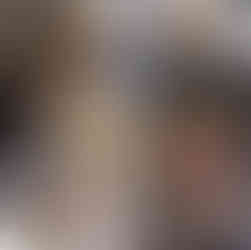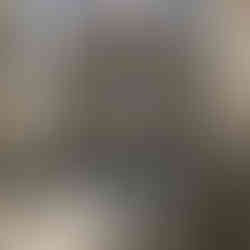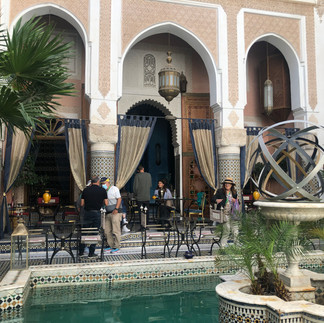Travel: Fez -1st Imperial City, Morocco 4/13/2024
- Lili Naveh
- Apr 13, 2023
- 11 min read
Continuation of a Guided Group Trip. which started on:
4/10 - From Tangier to Casablanca (part 1)
4/11 -Rabat- Imperial capital (part 2)
4/12/Meknez - Imperial Capital (part 3)

As mention in the previous post (4/12) the short drive from Meknez to the neighboring
Northern inland - Fez city took only about an hour

The nights of April 12t & 13th were spent at this Fez city's center hotel, which its lobby was most promising, though not so its actual rooms, despite the hotel's 5-star marketing, about its 3 swimming pools, tennis court and garden.,..

Zallagh Park Palace Hotel
Lostissement Qued Fes Rite Principal +212 53949949

Zakari the local guide next to prof. Uzi Rabi

On the morning of April 13th - our luckiest day , the group won the best English speaking guide , so far
Zakari youngest in age, turned out to be most prolific, wise, best looking and best dressed local tour guide.
He greeted the group with a large enthusiastic smile, ready to guide and teach us all he knew about Fes attractions.
Highly recommended
Guide in Fez - Zakaria Lassri +212672212777
Fez
In the 9th c Fez was the capital of the Idrisid dynasty, and is considered to be
the first imperial city of Moroccan Islamic state.

The first imperial city, located to the north west of the Atlas Mountains, Fez is the oldest and considered the spiritual ,cultural , scholastic capital of Morocco
Fez is the second largest city in Morocco, with a population of over 1.11 million
Surrounded by hills, the old city is centered around the Fez River (Oued Fes) flowing from west to east.
The city consists of 2 old medina quarters :
the original Fes el-Bali and the smaller Fes Jdid,
Much larger modern urban Ville Nouvelle area was founded during the French colonial .
Fez was founded under Idrisid rule (788 to 974), first Muslim ruling family. who Immigrated from the Saudi Hijaz and who imported Islam into the area.
Fez originally consisted of two cities during the 8th–9th c, However under Almoravid rule, in the 11th c, the Almoravid Sultan Yusuf ibn Tashfin the 2 neighboring settlements were united into what is today's Fes el-Bali quarter, and the city gained a reputation for religious scholarship and mercantile center
Arab immigrants from Tunisia and al-Andalus (Spain/Portugal) in the early 9th c gave the nascent city its Arab character
At its peak as a political capital. in the 13th c several new madrasas and mosques were constructed, many of which survive today, and other structures were restored. and are hallmarks of Moorish and Moroccan architectural styles
The tour started with a visit to:
Royal Palce in Fez Jdid District (UNESCO Heritage since 1981)

In 1276 the Marinid sultan Abu Yusuf Yaqub founded the royal administrative district of Fes Jdid, an extension of Fes el Bali (the old city or medina) where he built the a
Royal Palace (Dar al-Makhzen) royal citadel and capital which we visited.
This oldest and biggest palace complex has 12 gates around its fortified walls
It served as the new royal residence and center of government for Morocco under Marinid rule .wheres before , the main center of power and government in Fez had been the Kasbah Bou Jeloud on the western edge of the old city (at the location of the still extant Bou Jeloud Mosque
The Grand Mosque of Fes el-Jdid, adjacent to the palace grounds, was also founded at the same time at the new city in 1276 and was connected by a private passage directly to the palace, allowing the sultan to safely come and go for prayer
Upon arrival to the closed main gate, a thorough polishing work of the brass door was in progress by 3 workers hung off ladders. using lemons. as the traditional polish cleaning product
The vast grounds contains multiple private structures, patios, and gardens, but historically also included administrative offices and government tribunals.
The palace is still used on occasion by the King of Morocco, thus the most publicly visible parts of the palace are its main entrances at the Old Mechouar (to the northeast) and the highly ornate 20th-c gates at Place des Alaouites, near the Mellah (to the southwest).
Semarine main Southern gate to Jdid

Originally established in 1438 as a mean to insulate and protect the growing Jewish Fez population from outside influence and threats, the Mellah (Jewish quarter) was formed on the south side of this new district. located in Fes el-Jdid,

Fez became a Jewish religious, intellectual and cultural center with intense correspondence on religious questions and answers.
A number of major figures such as Dunash Ben Labrat (poet, 920-990 ad), Judah ben David Hayyuj (or Abu Zakariyya Yahya; grammarian, 945-1012 ad ), and the great Talmudist Isaac al-Fasi (1013-1103) were all born or spent time in Fez
Maimonides (RAMBAM) 1135 born in Cordova, died in Chairo 1204 but also lived in Fez from 1159 to 1165 after fleeing al-Andalus Spain

While the district is no longer home to any significant Jewish population, it still contains a number of monuments and landmarks from the Jewish community's historical heritage in the city..

The Jewish houses in the Mellah often have open balconies facing the street and a greater number of windows. which are notably and distinctively different from the traditional old houses in the rest of the city's. Muslim neighborhoods characterized by very few exterior features and generally closed-off from the outside.
Among the best-known synagogues of the Mellah are the Ibn Danan Synagogue,
(end of 17th c), and the Slat al-Fassiyin Synagogue, reputed to be the oldest synagogue of the Mellah and possibly dating from the Marinid period (13th-15th c)
Ibn Danan Synagogue
Other synagogues in the Mellah were merely pre-existing rooms within private residences , that were converted by the owners into places of worship
For a few centuries the Sephardic (Spanish) Jews, known as Megorashim, and the Moroccan (Arab or Berber) Jews, known as Toshavim, worshiped in separate synagogues, until the Sephardic tradition (minhag) eventually prevailed in most aspects of religious practice.
The Slat al-Fassiyin Synagogue was one of the few where non-Sephardic rituals continued up until the 20th c

The Jewish Cemetery
The city's original Jewish cemetery was also located near here, just outside the gate of Bab Guissa.
The blindingly white semi-cylindrical tombs, all freshly painted in 2019 are of a cemetery established in 1883
Main Entrance to the Cemetery

The Tragedy of Solica
The 19th-c martyr Solica, is venerated by Jews, Muslims alike, and assorted rabbis, She is buried here
Solica, who is also known as Sol Hachuel and Lalla Suleika, was born in Tangier in 1817. where local governor is said to have offered her great wealth to convert, so that her beauty would be a credit to the Muslims
However ,when she refused him, then he charged and tortured her
She was transferred to Fez, where she was beheaded in 1834, at age 17.
Walking the allies of the old Jewish quarter
Following the visit to the el-Jdid district , the 40 minutes scenic drive outside the residential areas, and through panoramic views,, brought us to a Ceramic Tile -Zellige
shop-work/factory
Panoramic views

Due to the furnace pollution that the Ceramic Tile -Zellige industry creates,, it is not aloud , any longer, for the ceramic making workshops to be situated within the city's residential districts, as it was for many years


At the Zellige - Hand Made Ceramic Tiles factory

Grand chic- Poterie et Zelige Expedition tous pays
Rte de Sidi Harazem- Ain Nokbi Fekharin 18 Bloc 4 Fez
+212 535761653 +212661358878 Artdepoteriedefes@gmail.COM
The company is owned and operated by Idriss Fenassi, who has been producing Moroccan handmade pottery for many years using an amalgam of ancestral techniques and knowledge with a modern touch.

The word zillīj is derived from the verb zalaja meaning "to slide" in reference to the smooth, glazed surface of the tiles.
The tradition dates back over 1000 years. The style of mosaic tilework is made from individually hand-chiseled tile pieces. most notably with elaborate Islamic geometric motifs such as radiating star patterns.

The generic tiles drying out

A demonstration of the art work making in clay, done in the old traditional manual way , was given prior to entering the large shop.
The Tourist Shop

Driving toward the Medina the old historic center of town

Medina el Bali- the oldest walled part of Fez World Heritage Site
The walls that surrounds Morocco’s best-preserved medina are situated on a rocky hillside and hosts a maze of narrow streets, 13th-ce buildings and busy markets.
It is thought to be one of the world's largest urban pedestrian zones that bans cars.
Donkeys mules and motorized bikes, are commonly used for transportation in the old city's maze of narrow allies. that lead to bustling markets and bazaars
Bab Bou Jeloud

The old Bab Bou Jeloud ornate city gate in Fes el Bali, was a simple, modest gate that may have dated essentially from the 12th c
The current gate was built by the French colonial administration in 1913 to serve as the grand entrance to the old city
Composed of central arch ,and 2 side small ones delicate arabesque and knot work blue (paradise) on the exterior facade and green (water) on the interior
Next to it there is also an ancient water distributor- the medina's essential water supply network developed in the 11th c by the Almoravides that made running water accessible to the mosques, madrassas, Fonduks-inn, Hammams fountains and homes of the wealthy.

Place el-Baghdadi
The name refer to a parade ground or military square, large square known as
Place Bou Jeloud -now also called Place el-Baghdadi which once hosted story tellers, entertainers, snake charmers.
It borders by historical ramparts and the prestigious Lycee Moulay Driss -High Scool which was recently rehabilitated and is open to the public.
just west of the gate,. located near the site of what used to be one of the main citadels of Fes el-Bali, is the Kasbah Bou Jeloud, as well as near the Kasbah en-Nouar

Souq-Market
The gate gave access directly to the start of Tala'a Kebira, the main souq street that crosses the medina and leads to the Qarawiyyin mosque and university at the heart of the city.

The Metal Worker Square
The market's squares space, is divided to specialized professional guilds till today, so in addition to the Metal Workers there are the Shoe Makers - Cherabiliyin, Herbs/cosmetics specialists- El Attarin,, Carpenters - E Nejjarin, and Tanneres.
Oldest University - Al-Qarawiyyin

The University of Al-Qarawiyyin ,meaning - "University of the People from Kairouan "
is considered by some to be the oldest continuously functioning institute of higher education in the world..
Fatima al-Fihriya Statue

It was founded as a mosque by Fatima al-Fihri in 857–859 and subsequently became one of the leading spiritual and educational centers of the Islamic Golden Age.
Fatima's story is told by Ibn Abi Zar' (d. between 1310 and 1320) in The Garden of Pages (Rawd al-Qirtas) as founder of the mosque.
Since she was first mentioned many centuries after her death, her story has been hard to substantiate and some modern historians doubt she ever existed.
T
he little know about her is that Fatima was born around 800 AD in the town of Kairouan, in present-day Tunisia, of an of Arab Qurayshi descent, migrating to Fez
The most emblematic landmark of the city

Al-Qarawiyyin Mosque
It was with the wealth inherited from her deceased merchant father -, Mohammed al-Fihri,, together with her sister Maryam that these incredible women left their mark and legacy in the old town building the Al-Qarawiyyin Mosque
Some teaching and instruction probably took place at al-Qarawiyyin Mosque from a very early period[.
The mosque building itself is also a significant complex of historical Moroccan and Islamic architecture that features elements from many different periods of Moroccan history
Distinguish scholars studied and taught here. Philosophers like ,Kaldun and Averroes
historians like Ibn Khaldoun, doctor philosophers like Maimonides, geographers
like Ali Isrissi, and mystics like Ibm Hirzihim, Abou Modyane, Abdslam ben Machich

Scholars consider al-Qarawiyyin to have been effectively run as a madrasa until after World War II. It was incorporated into Morocco's modern state university system in 1963 a
Education at the University concentrates on the Islamic religious and legal sciences with a heavy emphasis on, and particular strengths in, Classical Arabic grammar/linguistics and MalikiSharia, though lessons on non-Islamic subjects are also offered to students. Teaching is still delivered in the traditional methods
Students from all over Morocco and Muslim West Africa, attend with some also coming from further abroad. Women were first admitted to the institution in the 1940s
Zawiya of Moulay Idris II shrine in the Medina

The Islamic shrine and religious complex, one of the holiest shrines in Morocco, contains the tomb of Idris II who is considered the main founder of the city of Fez and who ruled Morocco from 807 to 828

The current building which went a major reconstruction under Moulay Ismail in the early 18th c gave the sanctuary its overall current form, including the minaret and the mausoleum chamber with its large pyramidal roof.
Bou Inania Madrasa -an architectural /cultural complex


A Madrasa , ablution room (wash room) and, Hydraulic clock - la Magana built by astronomer master - ,Abu lhassan Ali Tlemsani can all be found here.
Built in 1351–57 by sultan Abu Inan Faris. the son and successor of Sultan Abu al-Hasan, under whose reign of the Marinid empire reached its apogee and expanded all the way to Tunis in the east., the madrasa complex is stunning.
The Marinids were prolific builders of madrasas, a type of institution which originated in northeastern Iran by the early 11th cand was progressively adopted further west
and served to train Islamic scholars, particularly in Islamic law and jurisprudence
The Bou Inania Madrasa, acknowledged as a high point of Marinid architecture and of historic Moroccan architecture generally. was the largest and most important madrasa created by the Marinid dynasty. It turned into one of the most important religious institutions of Fes and Morocco, and It is the only madrasa in Morocco which also functioned as a congregational mosque.

Motives of King Salomon Seal - depicted in the shape of either a pentagram or a hexagram, a star with 8 corners, also found first in Dome of the Rock in Jerusalem as well as delicate sculpted plaster panels, marble, wooden Ceder wood doors, and Babylon originated zellige ceramic mosaic in green and blue which also wondered to Andalusia , can all be found in the decor of the walls
Visit in a small palace - Kasar Annoujoum - +212 602-628043

There are several beautiful palaces, where the wealthy families of Fez once resided inside the medina ,then abandoned,and which later transformed into restaurants, cafes and Riads/hotel for the tourists.
The historic palace , we visited , dating from the early 19th c, was built for a noble Alwite family in 1820, and became after 5 years of restoration the headquarter for an Italian private institution - Ducci Foundations which is based in Rome
The foundation was founded in 1999 to to promote intercultural dialogue
Containing a mixture of styles its court Kasar Annoujoum is considered one of the most elegant in Fez. Its coffee shop, court, and collection of art is open to the public and
After the overthrow of the Marinid dynasty, Fez declined competed with Marrakesh for political and cultural influence. and only became the capital again under the 'Alawi (Alaouite) dynasty ( the current Moroccan royal family) from the 17c up until 1912.
Lunch at La Medina Restaurant
13, bis Derb El Hammam - Guerniz, fès Médina (Tel:05 35 63 58 57)

Another traditional Moroccan food restaurant but in a beautiful setting, which only our local guide- Zakari, could lead us into it, through the winding maze of the medina, and still half of the group got lost on the way,...
At the Carpet and scarf store
A demonstration of traditional manual carpet weaving, was givien in
one of the colorful stores, at the crowded medina, along with a lessons on how the traditional head scarf are put
Last stop of the day at the Tannery
The visit to the Tannery production in the midst of the medina, right after lunch, is not that great idea, unless one is keen on purging the food just eaten and whichcab be triggered by the horrible odor...
leather trade - Morocco has long been famous for this trade


The Fez medina is a host to the Chouara Tannery from the 11th c, one of the iconic oldest tanneries in the world.
Here, workers, using pigeon extractions soften and transform animal skins into brightly-colored leathers by soaking them in pits/pools awash with colored dye
The area was heavily renovated in 2016, but the scene, viewed from the surrounding balconies, let a lone the unbearable smells, remain remarkably medieval.
It's striking to see the hard physical labor that goes into the butter-soft, elegant leather goods sold in the surrounding workshops.
The only way to see the tanneries in action is by walking through one of the leather shops, each of which has a terrace and many rooms with colorful merchandise
To be Continued,,,,,,






























































































































Comments